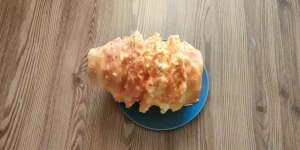
Sękacz - Tasty Polish Spit Cake
Jump to recipe
Hey food enthusiasts! Today, I want to talk about one of Poland's most renowned and iconic desserts - sękacz. This unusual baking with a characteristic structure and rich taste won the hearts of many cake lovers. I invite you to explore the history of sękacz. Let's discover its unique recipe and method of preparation and enjoy its unique taste.
Sękacz, is also known as "spit cake" or "tree cake". It is related to the German Baumkuchen, the Swedish spättekak, and closely related to the Lithuanian šakotis. This unique type of cake consists of simple ingredients. All you need is some butter, eggs, flour, sugar and cream. Its characteristic form imitates a tree with knots. The name "sękacz" actually comes from the Polish word "sęk", which means knot or burl in English.
The history of sękacz
The practice of baking layers of dough over an open fire, later became popular in Poland during the Polish-Lithuanian Commonwealth (1569-1791). But we can trace this tradition back to even earlier times. Similar to many aspects of European history, the concept originated from the ancient Greeks. Over time, different regions developed their own variants. What distinguishes them is their own technique of preparing and processing the dough.
According to one legend, Lithuanians and Poles inherited this delicacy. It was created by the Baltic Yotvingian tribe, which settled in Podlasie in the Middle Ages.
Over the years, Sękacz has established itself as a significant element of the gastronomic heritage of northern Poland. It is often eaten during family gatherings, weddings, or special occasions. Its inclusion on dining tables represents happiness, hospitality, and longstanding customs. Additionally, it is commonly chosen as a cherished present for loved ones to commemorate diverse celebrations.
How to prepare Sękacz?
Special equipment is necessary for baking the cake. It includes a unique wooden roller made of oak, which is wider on one side and narrower on the other. The process also requires a stove with a specific oven designed for baking this type of cake. This specialized oven is equipped with a firebox or electric heat source along with supports called grates. The roller rests and rotates on these grates. Below the cylinder, there is a metal spoon, called a ladle, from which the prepared dough is poured onto it. It is scooped from the bottom using another ladle-like tool called a "spoon". The fireplace itself is located adjacent to these elements.
Preparing the dough can be relatively simple, but time-consuming. Baking is more challenging and takes a lot more time. In total, it is about 4-5 hours. About three hours are dedicated to working at high temperatures near the hot stove.
Creating such an elaborate structure within home settings proves exceptionally challenging. However, there exist some individuals who have accomplished this task.
Recipe informations:
Ingredients
- 10 fresh eggs
- 250 ml of cream
- 250g of flour
- 250g of sugar
- 250g of butter
- juice of 1/4 lemon
- 1 vanilla sugar
